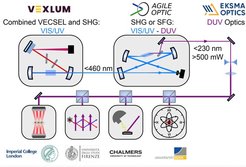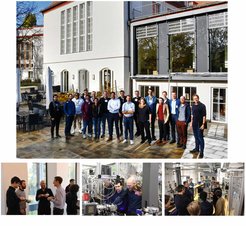The Cold Molecule Group
Deep Ultraviolet Lasers for Quantum Technology (UVQuanT)

Lasers play an essential role in science, technology, medicine, communication, and industry, and underpin all four pillars of the Quantum Technologies Flagship initiative. However, for the spectral region in the deep ultraviolet (DUV), especially for wavelengths below 266 nm, laser applications are severely constrained by the available light sources and optical components. The purpose of UVQuanT is to demonstrate new DUV laser systems and leverage advantages of DUV light in emerging quantum technologies (QT).
UVQuanT is a collaborative project between acadmemia and industry funded by the European Union's Horizon 2021 progamme. The project runs for 4 years from October 2022.
Our Mission: DUV lasers for the masses
Commercial, narrowband, continuous-wave DUV sources suffer from low output power (< 200 mW), poor beam quality, are complex, expensive and often degrade over hours. Currently, a system typically costs in excess €250k, with significant maintenance overhead and a large spatial footprint. The chief reason for this is that no robust, tuneable laser gain medium has been demonstrated in the DUV, and light must be generated by up-converting light from visible or infrared laser sources. This usually requires a high power (>3W) infrared laser source, and two stages of second harmonic generation (SHG) to convert infrared to ultraviolet light. To acheive sufficient SHG conversion efficiency, a SHG active medium must be mounted inside an optical cavity. Even with the best available technology, small problems in this optical chain accumulate into large degradation or variation in the DUV output.
Our mission is to systematically improve all parts of the optical chain to demonstrate robust, cheaper, smaller DUV lasers which can be taken out of the research lab and eventually into industry. Or, put simply, to bring DUV lasers closer to mass application. Along the way, we will also improve infrared and visible laser sources, and the optics bringing DUV light from laser to user.
Our Approach: Combine the best from academia and industry
Our approach is to bring together a set of partners from industry and academia, focussing expertise on target wavelengths for quantum technology applications. This enables rapid feedback between user and manufacturer, streamlines development and maximises the impact of our results.
Broadly speaking, our strategy is summarised as follows:

- Develop cheaper and robust visible/infrared laser sources which are designed with high SHG conversion efficiency in-mind. In this respect, Vertical-extended-cavity surface-emitting-lasers (VECSELs) have a proven track record in the 1500-1000 nm range, and VECSEL extending capability down to 850 nm would allow access to the DUV via two stages of SHG.
- Design compact SHG cavities tailored for maximum conversion efficiency when seeded with VECSEL lasers, which are clean and DUV-suitable.
- Understand the causes of DUV optics degradation, to develop high performance, long-lasting optical components and mitigate laser damage.
- Deploy the improved laser systems in ongoing research projects targetting next-generation atomic optical clocks, atom accelerometers, quantum simulators based on ultracold molecules, and new material characterisation via angle-resolved photoelectron spectroscopy.
UVQuanT Partners
Industry partners:
Academic partners:
- Fritz Haber Institute
- Imperial College London
- University of Bonn
- Università degli Studi di Firenze
- Chalmers University of Technology
Our Kick-off Meeting (October 2022)

In October 2022, we gathered all our participants in Berlin to plan the details of the project and discuss the latest developments relevant to DUV lasers. The meeting was hosted at the Max Planck Society's Harnack House, allowing tours of the various experiments around the Fritz Haber Institute. We were very happy to welcome external participants Markus Arndt (University of Vienna), Fabian Wolf (PTB), and Benjamin Sprenger, Sandra Devega and Gabrielle Thomas (Menlo Systems) to give outside advice.
Project Handbook


